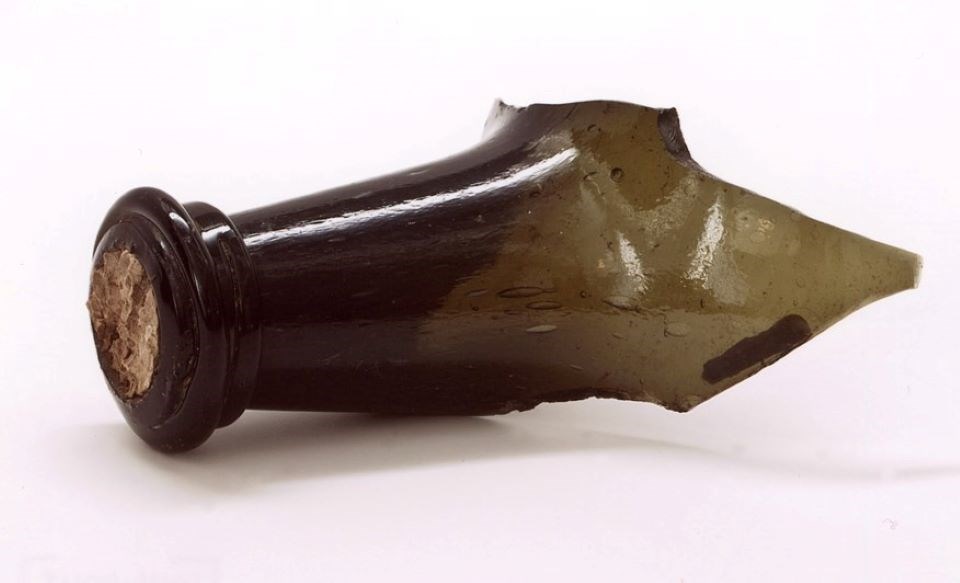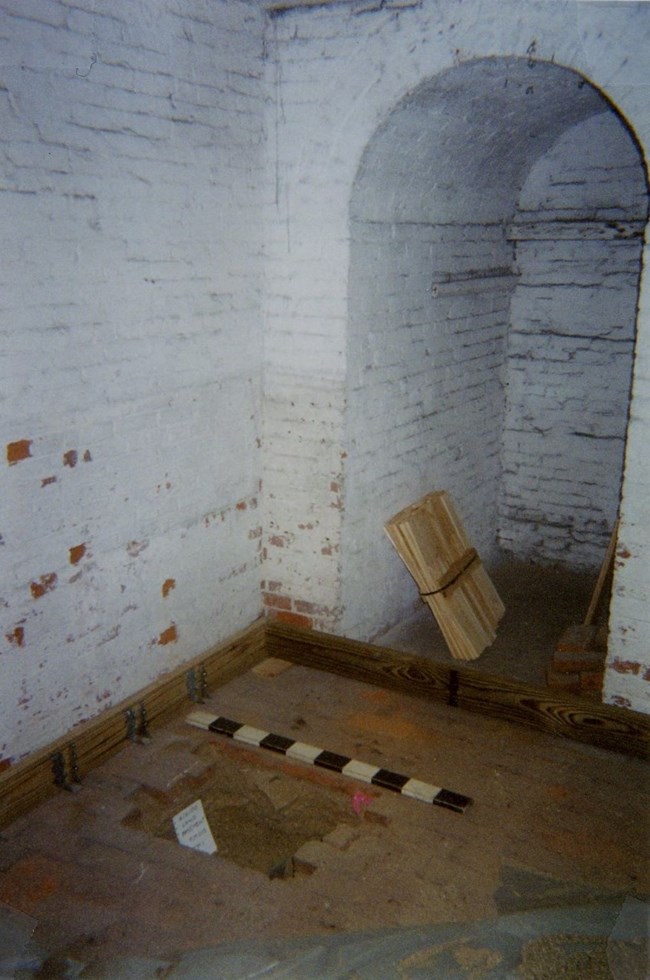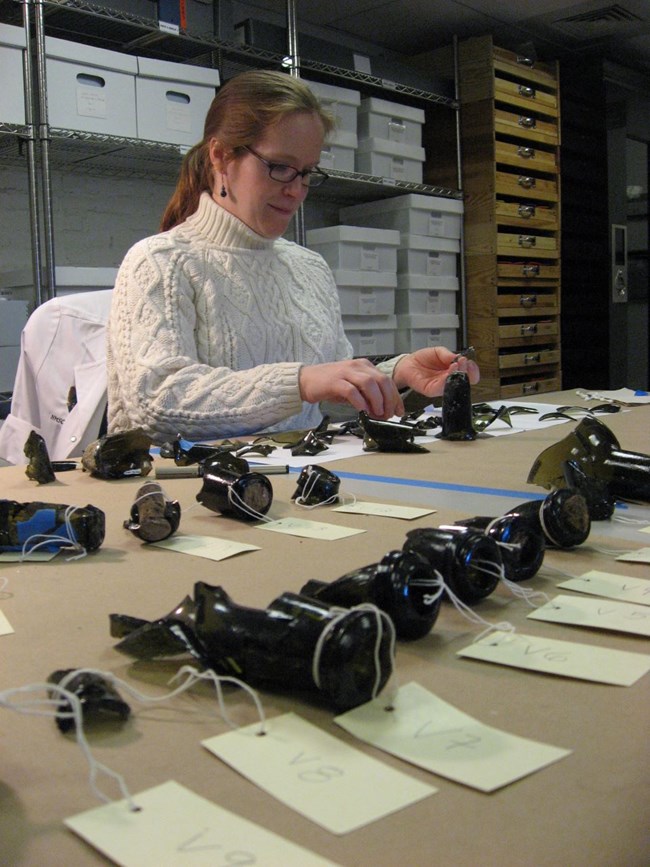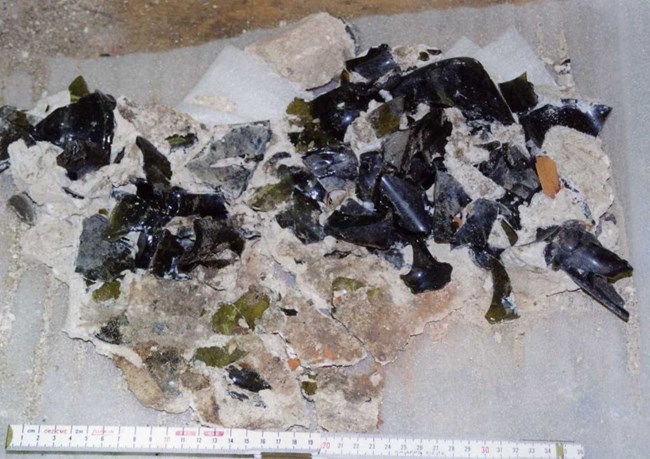Last updated: February 17, 2022
Article
Were These Washington's Wine Bottles?

NPS Photo
In 1775, General George Washington established his first major headquarters of the American Revolution in a large Georgian mansion on the Charles River in Cambridge. The house, later the home of poet Henry Wadsworth Longfellow, is today filled with the Victorian furniture of its later owners. Archeology at the site provides a tantalizing glimpse at some of the material remains of its earliest occupants, possibly including Washington himself.

NPS Photo
Field Work
In 2001 the house's basement was renovated to accommodate expanded curatorial space. The brick floor was removed and NPS archeologists were called in to excavate two unusual deposits. The deposits were composed of historical artifacts and well-preserved biological material all held together by a mortar and sand mixture. Part of the feature extends beneath a wall built circa 1791. The feature was most likely created to level and stabilize a depressed section of the dirt floor in advance of the construction of the wall. This depression may be evidence of a pre-existing trash pit for kitchen scraps and period rubbish.
Architectural analysis of the site provides a 32-year window to date this archeological deposit, found inside the basement built in 1759 and below a wall from circa 1791.

NPS Photo
Lab Analysis
A total of 1,546 items were recovered from the two features. The items were cataloged and analyzed by archeologists at the Northeast Museum Services Center in 2011. Glass wine bottle fragments make up 80% of the artifacts assemblage. Ceramic and glass artifacts can break into many pieces. Each fragment does not necessarily represent a single bottle or plate. Archeologists try to establish a minimum vessel count for an archeological site. The process can be tricky, but there are several clues that can aid this effort. In the case of this wine bottle collection, there are a total of twenty bottle necks. A single bottle does not have more than one neck, so archeologists were able to determine that they would be reconstructing at least twenty bottles.

NPS Photo
Reconstructing the bottles is helpful to determine age based on the style and shape of the bottle. The bases and necks of these bottles are representative of styles from the last quarter of the 18th century. The earliest date suggested by these identifying features is circa 1730; the latest is circa 1810. At that time both wine and spirits were stored in dark olive-green glass bottles.
The larger size of the glass fragments as well as intact corks in the necks suggests that the wine bottles were stored in the basement and likely had contents before they were broken.

NPS Photo
Whose Trash is it?
Between 1759 and 1791 the house was home to several families. Both the Vassall family (1759-1774) and the Craigie family (1791 on) were interested in botany and horticulture and purchased many plants for the yard. Evidence of fruit bearing trees, rye grass, cactus, and butterfly wings all speak to both the indigenous and exotic plants on the property.
The house served as headquarters for George Washington and his officers from July 1775 to April 1776. During Washington’s nine-month occupation of the house, his steward, Ebenezer Austin kept meticulous account books of expenses for food, drink and household goods. The account books list orders for mutton, fowl, butter, eggs, fish, smoking pipes, a sugar pot, and an earthen platter. Washington used the ground floor room to the right of the entrance as his dining room and entertained numerous visitors.
Seeds of Evidence or Bones of Contention?
The well-preserved biological material adds some additional clues. Seeds, eggshell fragments, oyster shells, and animal bones were well-preserved in the feature. Fish, goat, chicken, rabbit, and rock dove are all represented. Seeds from a muskmelon or cucumber, apple, or pear were also recovered from the basement; these fruits are listed as being purchased during Washington’s time in the home. Three cherry stones were also recovered; Ebenezer Austin entered payment for cherries in at least two different days in August 1775. One half of an olive pit was also recovered. Austin does not list any purchases for olives, but records from 1772 and again in 1783 document that George Washington ordered olives for his household in Mount Vernon.
The plant and animal remains and seeds represent dietary items common to upper class 18th century families. These materials would have degraded quickly so they must have been relatively fresh prior to their incorporation into the mortar mixture. The identified plant remains as well as the presence of sap beetles and the mourning cloak butterfly wing suggests a deposit from mid to late summer into fall. However the cherries and the olives could have been preserved year-round.
Conclusion
So, were these Washington's wine bottles? We simply aren’t sure.
Historical archaeology is a combination of historic research, architectural analysis, and archeological excavation. Though there is no confirming evidence that this deposit dates from the mere nine months that George Washington occupied the house, the 32-year window between 1759 and 1791, the date range of reconstructed vessels, and the detailed accounts by Ebenezer Austin all support the association.
References
Bain, Allison
n.d "Longfellow House Archaeoentomological Analysis"
Dumbrell, Roger
1983 Understanding Antique Wine Bottles. Collector’s Club, Woodbridge, Suffolk.
Largy, Tonya
2004 "Analysis of Biological and Other Material from Room 010 Longfellow National Historic Site, Cambridge, MA."
Pendry, Steven
2001 "Management Summary Archeological testing Longfellow House Cellar Room 010 Longfellow National Historic Site, Cambridge, MA."
Van den Bossche, Willy
2001 Antique Glass Bottles: Their History and Evolution (1500-1850). Collector’s Club, Woodbridge, Suffolk.
